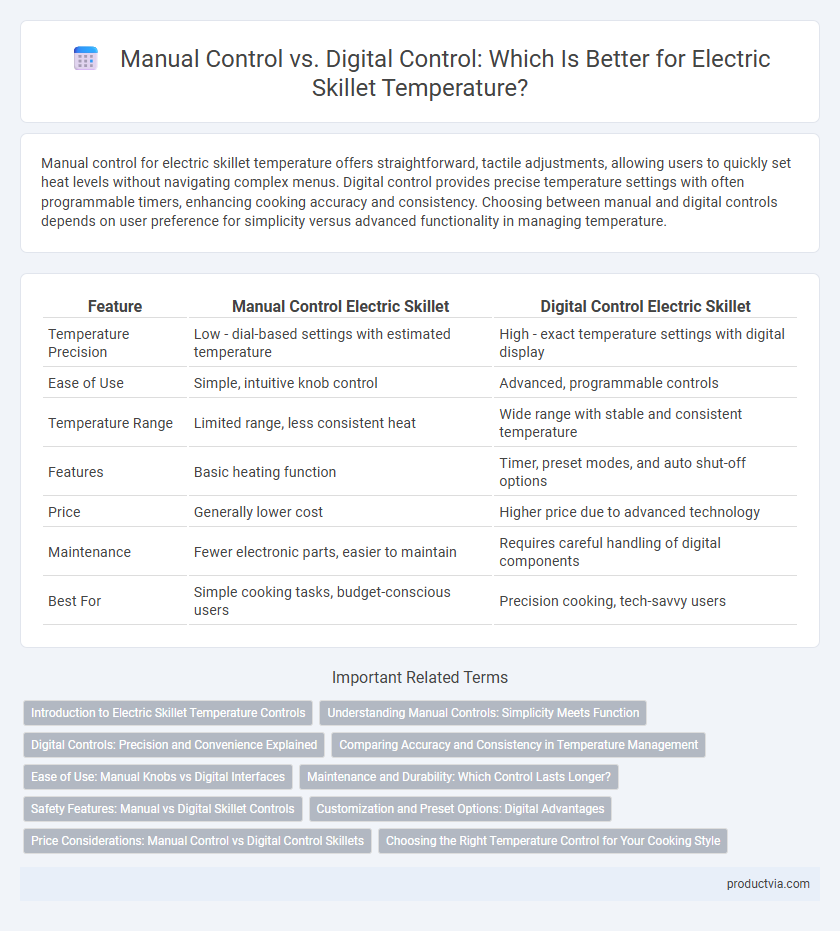Manual control for electric skillet temperature offers straightforward, tactile adjustments, allowing users to quickly set heat levels without navigating complex menus. Digital control provides precise temperature settings with often programmable timers, enhancing cooking accuracy and consistency. Choosing between manual and digital controls depends on user preference for simplicity versus advanced functionality in managing temperature.
Table of Comparison
| Feature | Manual Control Electric Skillet | Digital Control Electric Skillet |
|---|---|---|
| Temperature Precision | Low - dial-based settings with estimated temperature | High - exact temperature settings with digital display |
| Ease of Use | Simple, intuitive knob control | Advanced, programmable controls |
| Temperature Range | Limited range, less consistent heat | Wide range with stable and consistent temperature |
| Features | Basic heating function | Timer, preset modes, and auto shut-off options |
| Price | Generally lower cost | Higher price due to advanced technology |
| Maintenance | Fewer electronic parts, easier to maintain | Requires careful handling of digital components |
| Best For | Simple cooking tasks, budget-conscious users | Precision cooking, tech-savvy users |
Introduction to Electric Skillet Temperature Controls
Electric skillet temperature controls come in two primary types: manual and digital, each offering distinct levels of precision and user experience. Manual controls use a dial or knob allowing users to adjust heat settings intuitively, while digital controls feature precise temperature settings and often include timers for consistent cooking results. Understanding these control types helps select an electric skillet that matches cooking needs and preferences.
Understanding Manual Controls: Simplicity Meets Function
Manual control for electric skillets offers straightforward temperature adjustment through a dial or knob, allowing precise, tactile feedback ideal for users seeking simplicity and reliable function. This analog system provides consistent heat settings without the complexity of digital interfaces, making it accessible for basic cooking tasks. Manual controls emphasize ease of use and durability, often preferred for their intuitive design and immediate response in temperature regulation.
Digital Controls: Precision and Convenience Explained
Digital controls in electric skillets offer precise temperature settings often adjustable in small increments, ensuring consistent cooking results. These advanced controls provide convenience through preset cooking modes, timers, and easy-to-read displays that simplify operation. Enhanced accuracy reduces the risk of overcooking or undercooking, making digital electric skillets ideal for complex recipes and frequent use.
Comparing Accuracy and Consistency in Temperature Management
Electric skillets with digital control offer superior accuracy and consistency in temperature management compared to manual control models, as digital sensors precisely regulate heat levels. Manual control relies on a dial mechanism that can fluctuate due to user adjustments and less responsive temperature sensors, leading to potential cooking inconsistencies. For tasks requiring precise temperature maintenance, digital controls reduce the risk of overheating or undercooking by maintaining stable and exact heat settings.
Ease of Use: Manual Knobs vs Digital Interfaces
Manual control electric skillets feature knobs that offer straightforward, tactile adjustments, allowing users to quickly set and modify temperature without navigating menus. Digital interfaces provide precise temperature settings and often include preset cooking modes, but may require a learning curve for users unfamiliar with touchscreen or button-based controls. Ease of use depends on preference; manual knobs suit users who prioritize simplicity and immediate feedback, while digital controls appeal to those seeking accuracy and advanced functionality.
Maintenance and Durability: Which Control Lasts Longer?
Manual control electric skillets feature simple mechanical knobs that are easier to clean and less prone to electronic failure, enhancing their long-term durability. Digital control skillets offer precise temperature settings but may require more careful maintenance due to sensitive electronic components prone to wear or damage. For longevity, manual control generally lasts longer with minimal maintenance, while digital controls demand cautious handling to preserve their functionality.
Safety Features: Manual vs Digital Skillet Controls
Manual control electric skillets rely on a physical dial or knob to adjust temperature, offering straightforward operation but limited precision in maintaining consistent heat, which may increase the risk of overheating and burns. Digital control skillets provide precise temperature settings through electronic sensors and displays, enhancing safety by allowing automatic shutoff and temperature regulation to prevent accidents. The integration of programmable safety features in digital models makes them superior in minimizing hazards compared to manual controls.
Customization and Preset Options: Digital Advantages
Digital control electric skillets offer enhanced customization with precise temperature settings adjustable to the exact degree, unlike manual dials that provide approximate ranges. They feature preset cooking programs tailored for specific dishes like pancakes or stir-fry, simplifying meal preparation and ensuring consistent results. This technological advantage allows users to replicate recipes with accuracy and reduces the guesswork involved in achieving ideal cooking temperatures.
Price Considerations: Manual Control vs Digital Control Skillets
Manual control electric skillets generally come at a lower price point due to their simpler design and fewer electronic components. Digital control skillets, featuring precise temperature settings and programmable functions, tend to be more expensive but offer enhanced cooking accuracy and convenience. Consumers balancing budget and cooking needs often opt for manual models for affordability, while digital options appeal to those prioritizing advanced features despite the higher cost.
Choosing the Right Temperature Control for Your Cooking Style
Manual control electric skillets offer straightforward temperature adjustment through a dial, providing tactile feedback ideal for cooks who prefer hands-on, intuitive settings. Digital control skillets deliver precise temperature regulation with LED displays and preset functions, enhancing accuracy for recipes that require consistent heat. Selecting between manual and digital temperature controls depends on your cooking style--manual suits flexible, experiential cooking, while digital supports exact temperature maintenance for delicate dishes.
Manual Control vs Digital Control for Electric Skillet Temperature Infographic

 productvia.com
productvia.com